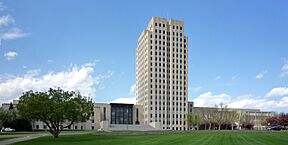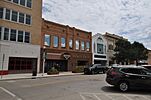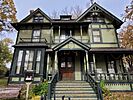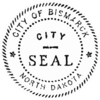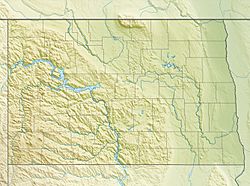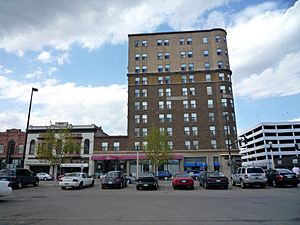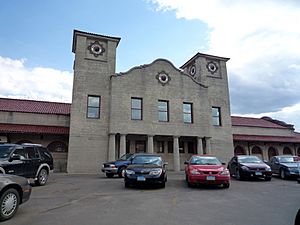Bismarck, North Dakota facts for kids
Quick facts for kids
Bismarck
|
|||||
|---|---|---|---|---|---|
|
North Dakota State Library
Burleigh County Courthouse
Webb Brothers Block on East Main Avenue
Downtown Historic District
Old Governor's Mansion
|
|||||
|
|||||
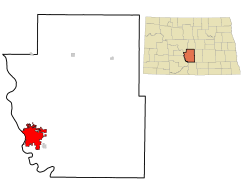
Location of Bismarck in Burleigh County, North Dakota
|
|||||
| Country | United States | ||||
| State | North Dakota | ||||
| County | Burleigh | ||||
| Founded | May 14, 1872 | ||||
| Incorporated | January 14, 1875 | ||||
| Named for | Otto von Bismarck | ||||
| Area | |||||
| • City | 35.182 sq mi (91.121 km2) | ||||
| • Land | 34.685 sq mi (89.834 km2) | ||||
| • Water | 0.497 sq mi (1.288 km2) | ||||
| • Urban | 41.85 sq mi (108.4 km2) | ||||
| • Metro | 4,281.1 sq mi (11,088 km2) | ||||
| Elevation | 1,745 ft (532 m) | ||||
| Population
(2020)
|
|||||
| • City | 73,622 | ||||
| • Estimate
(2023)
|
75,092 | ||||
| • Rank | US: 497th ND: 2nd |
||||
| • Density | 2,146.32/sq mi (828.69/km2) | ||||
| • Urban | 98,198 (US: 316th) | ||||
| • Urban density | 2,346.27/sq mi (905.89/km2) | ||||
| • Metro | 135,786 (US: 305th) | ||||
| • Metro density | 31.49/sq mi (12.16/km2) | ||||
| Time zone | UTC–6 (Central (CST)) | ||||
| • Summer (DST) | UTC–5 (CDT) | ||||
| ZIP Codes |
58501, 58502, 58503, 58504, 58505, 58506, 58507
|
||||
| Area code(s) | 701 | ||||
| FIPS code | 38-07200 | ||||
| GNIS feature ID | 1035934 | ||||
| Highways | US 83, I 94, I 94 Bus., I 194, ND 810 | ||||
| Sales tax | 7.5% | ||||
Bismarck (/ˈbɪzmɑːrk/) is the capital city of North Dakota. It is the second-largest city in the state, after Fargo. In 2020, about 73,622 people lived here. By 2023, the population was estimated to be around 75,092.
Bismarck was started by European-Americans in 1872. It is located on the east bank of the Missouri River. Since 1889, Bismarck has been North Dakota's capital. This was when North Dakota became a state.
The city of Bismarck is right across the river from Mandan. These two cities form the main part of the Bismarck metropolitan area. The North Dakota State Capitol building is in Bismarck. The state government is a big employer here. Bismarck is also a key place for shopping and healthcare in this part of North Dakota.
Contents
Bismarck's Story: A Look Back
For thousands of years, different indigenous peoples lived in this area. The historic Mandan Native American tribe lived here long before Europeans arrived. The Mandan and Arikara people had their own names for this place.
In 1872, a settlement was started here. It was called Missouri Crossing because the Lewis and Clark Expedition crossed the Missouri River nearby. Later, it was named Edwinton. This was after Edwin Ferry Johnson, a chief engineer for the Northern Pacific Railway. The railway helped bring workers and settlers to the area.
In 1873, the railway changed the city's name to Bismarck. This was to honor Otto von Bismarck, a famous German leader. The railway hoped to attract German settlers and investors. Bismarck is the only U.S. state capital named after a foreign statesman.
A year later, gold was found in the nearby Black Hills. This caused the city to grow a lot! Many miners came, which led to problems with the Lakota tribe. Bismarck became an important shipping center for goods going to and from the Black Hills.
In 1883, Bismarck became the capital of the Dakota Territory. Then, in 1889, it became the capital of the new state of North Dakota.
Where is Bismarck?
Bismarck is located at 46°48′51.39″N 100°46′9.86″W / 46.8142750°N 100.7694056°W. The city covers about 35 square miles (91 square kilometers). Most of this area is land, with a small amount of water.
City Life and Buildings
Bismarck has grown around its downtown area. A unique thing about Bismarck is that its main shopping center, Kirkwood Mall, is right in the city center. Other big stores are also nearby. The city's two hospitals are also downtown.
New homes and businesses have been built in the northern part of the city. This is because more shopping centers have opened there.
The North Dakota State Capitol building is just north of downtown. This tall, 19-story building is the highest in the state. It was finished in 1934. The Capitol grounds also have the North Dakota Heritage Center, the North Dakota State Library, and the Governor's home.
The Cathedral District is a historic neighborhood near downtown. It's named after the beautiful Cathedral of the Holy Spirit. Some homes here are very old, from the 1880s. Many streets in this area have tall American elm trees.
After the Garrison Dam was built in 1953, it helped control floods. This made the land near the Missouri River safer for building. So, many homes and businesses have been built on the city's south side near the river.
Bismarck's Weather
Bismarck has four distinct seasons. Winters are cold, dry, and snowy. Summers are warm and humid. Thunderstorms happen in spring and summer. The warmest month is July, and the coldest is January. Snowfall in winter is usually light to moderate.
Who Lives in Bismarck?
In 2023, there were about 32,208 homes in Bismarck. On average, 2.23 people lived in each home. The median household income was $77,608. About 9.7% of the people in Bismarck live below the poverty line.
Most people in Bismarck are of European descent, with many having German and Norwegian backgrounds. The median age in the city is about 39.8 years old.
Jobs in Bismarck
The biggest employers in Bismarck are:
- The State of North Dakota government
- Bismarck Public Schools
- Sanford Health (a healthcare provider)
- Bobcat/Doosan Company (a manufacturing company)
- CHI St. Alexius Medical Center (another healthcare provider)
- Bismarck State College
These organizations provide many jobs for the people living in Bismarck.
Fun Things to Do: Arts and Sports
Arts and Culture
The Belle Mehus Auditorium is a historic building downtown. It's a key place for arts events. You can see performances by the Bismarck-Mandan Symphony Orchestra here. There are also several theater groups in Bismarck, including those at the University of Mary and Bismarck State College.
Sports Scene
Sports are a big part of life in Bismarck! High school and college sports are very popular.
- The three public high schools are Bismarck High School (The Demons), Century High School (The Patriots), and Legacy High School (The Sabers).
- St. Mary's Central High School (The Saints) is a Catholic high school.
- Bismarck State College and United Tribes Technical College have teams called The Mystics and Thunderbirds.
- The University of Mary teams are called The Marauders.
Football is very popular in the fall, with strong rivalries between the high schools. In winter, people enjoy ice hockey, wrestling, and basketball. In spring, baseball and softball are popular.
In the summer, you can watch American Legion baseball and auto racing. The city also hosts the Sam McQuade Sr. softball tournament, which is the world's largest charity softball event!
Bismarck also has a junior ice hockey team called the Bismarck Bobcats. They won a national title in 2010. Since 2017, the Bismarck Larks, a baseball team, play their home games at Bismarck Municipal Ballpark.
Parks and Outdoor Fun
Bismarck has many parks and trails. The Bismarck Parks and Recreation District manages over 2,300 acres (930 hectares) of parkland. Sertoma Park is a large park along the Missouri River. It has biking trails and the Dakota Zoo.
There are five golf courses in Bismarck. Hunting and fishing are also popular activities in the area. You can fish in the Missouri River all year round.
In 2007, Bismarck set a world record for the most snow angels made in one place! Over 8,900 people gathered at the capitol grounds for the event.
Learning in Bismarck
Schools for All Ages
The Bismarck Public Schools system has sixteen elementary schools, three middle schools, and three public high schools. They teach over 13,900 students.
There are also three Catholic elementary schools and three private high schools in the city.
Colleges and Universities
Bismarck has several options for higher education:
- The University of Mary is a four-year university.
- Bismarck State College is a two-year public college.
- United Tribes Technical College is a two-year tribal college.
- Sanford Health also runs a nursing school.
News and Media
Newspapers
Bismarck's daily newspaper is Bismarck Tribune. It started in 1873 and is the oldest business in the city.
TV and Radio
Bismarck is a center for television and radio in western North Dakota. There are five TV stations and many radio stations that broadcast from Bismarck. You can find stations playing different types of music, news, and sports.
Getting Around Bismarck
Public Transportation
The Capital Area Transit System, called Bis-Man Transit, offers bus service throughout Bismarck and Mandan. It runs Monday through Saturday.
Air Travel
Bismarck Municipal Airport is south of the city. It's the second busiest airport in North Dakota. Several airlines fly from here, connecting Bismarck to other cities.
Roads
Two major highways pass through Bismarck: Interstate 94 (east-west) and U.S. Route 83 (north-south).
Walking and Biking
Bismarck has a public bikeshare system called BisParks BCycle. It has four places where you can pick up and drop off bikes.
Famous People from Bismarck
- Leslie Bibb, actress
- Kent Conrad, former U.S. senator
- John Hoeven, U.S. senator and former Governor of North Dakota
- Brock Lesnar, famous wrestler
- Cara Mund, Miss America 2018
- Carson Wentz, professional football player
See also
 In Spanish: Bismarck (Dakota del Norte) para niños
In Spanish: Bismarck (Dakota del Norte) para niños


